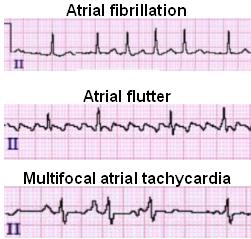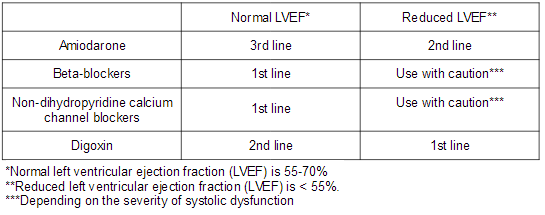Topic Reviews A-Z
Atrial Fibrillation - Quick Fact Sheet
Introduction
Atrial fibrillation (AF) -most common chronic arrhythmia, atrial rates 400-600, absence of P waves on ECG and irregularly irregular QRS Complexes. Distinguish from atrial flutter:
Paroxysmal atrial fibrillation: Self-limiting and sinus rhythm restores spontaneously. Lasts for less than 7 days. Does not require intervention to convert to a normal rhythm (electrical or chemical cardioversion).
Persistent atrial fibrillation: Lasts greater than 7 days. The term persistent is used when there is a plan to use a rhythm control strategy and return the patient to sinus rhythm.
Permanent atrial fibrillation: Atrial fibrillation is present 100% of the time for greater than 7 days and there are no interventions planned to restore sinus rhythm.
Causes
Pulmonary embolus, pulmonary disease, post-operative, pericarditis
Ischemic heart disease, idiopathic (“lone atrial fibrillation”), intravenous central line (in right atrium)
Rheumatic valvular disease (specifically mitral stenosis or mitral regurgitation)
Anemia, alcohol (“holiday heart”), advanced age, autonomic tone (vagally mediated atrial fibrillation)
Thyroid disease (hyperthyroidism)
Elevated blood pressure (hypertension), electrocution
Sleep apnea, sepsis, surgery
Diagnosis
Below find multiple full 12-lead ECG examples of atrial fibrillation:
- Atrial Fibrillation with Rapid Ventricular Rate (Example 1)
- Atrial Fibrillation with Rapid Ventricular Rate (Example 2)
- Atrial Fibrillation with Rapid Ventricular Rate (Example 3)
- Atrial Fibrillation with Rapid Ventricular Rate (Example 4)
- Atrial Fibrillation with Rapid Ventricular Rate (Example 5)
- Atrial Fibrillation with Normal Ventricular Rate (Example 1)
- Atrial Fibrillation with Normal Ventricular Rate (Example 2)
- Atrial Fibrillation with Normal Ventricular Rate (Example 3)
- Atrial Fibrillation with Bradycardia (Example 1)
- Atrial Fibrillation with Bradycardia (Example 2)
- Atrial Fibrillation with Bradycardia (Example 3)
Symptoms
Treatment
The treatment involves alleviating symptoms and preventing thromboembolism.
Alleviating symptoms involves either rate or rhythm control.
Rate control: When chosing AV blocking medications such as beta-blockers, calcium channel blockers or digoxin for rate control, be sure to know the ejection fraction.
Rhythm control: Antiarrhythmic drugs used to maintain sinus rhythm in atrial fibrillation include Class IA (rarely), class IC (flecainide, propafenone) or class III (sotalol, amiodarone, dronedarone). Cardioversion useful as well. Atrial fibrillation ablation indicated if 1 antiarrythmic drug fails.
CHADS 2 Vasc Score: Use to determine who needs anticoagulation for thromboembolic prophylaxis. Score 0-1 use aspirin 81-325 mg daily. Score > 2 then use full anticoagulation with either warfarin, dabigatran, rivaroxiban or apixaban.
The annual stroke risk according to the CHADS 2 Vasc score is as follows:
1 point = 1.3%
2 points = 2.2%
3 points = 3.2%
4 points = 4.0 %
5 points = 6.7 %
6 points = 9.8%
7 points = 9.6% (study had small sample size with this score, leading to more variability)
8 points = 6.7% (study had very small sample size)
9 points = 15.2%
Related links:
Atrial Fibrillation Multiple Choice Review Questions
Atrial Fibrillation Case Based Review Questions
Atrial Fibrillation Video Review
Atrial Fibrillation Jeopardy





